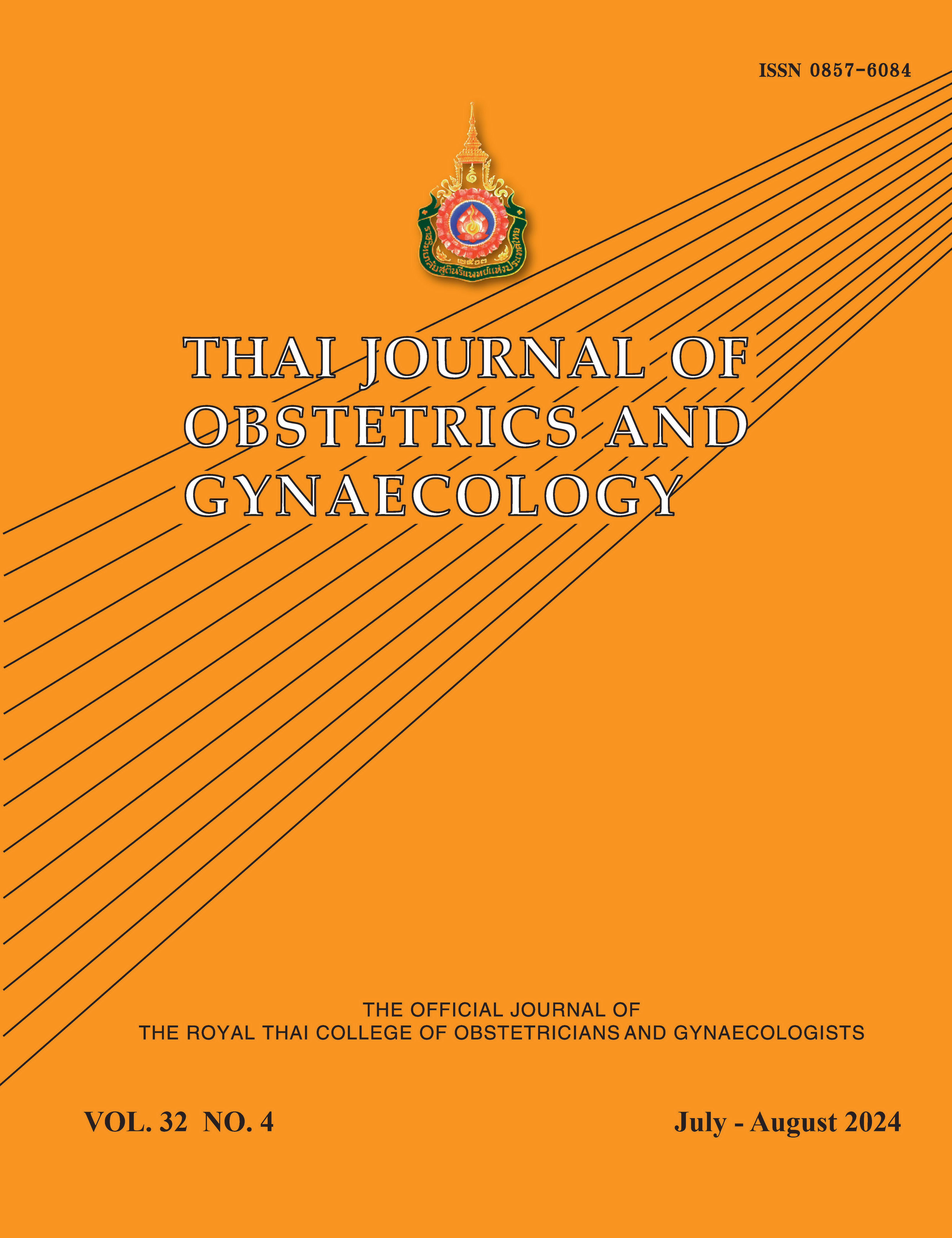A Comparison of Conventional Outpatient and Instrumental Intraoperative POP-Q Measurements in Patients Undergoing Vaginal Surgery for Pelvic Organ Prolapse
Main Article Content
Abstract
Objective: To compare the differences of Pelvic Organ Prolapse Quantification (POP-Q) measurements obtained preoperatively at the outpatient setting and intraoperatively with instrumental traction during full anesthetization in patients undergoing vaginal reconstructive surgery.
Materials and Methods: Retrospective chart review of 98 women having undergone vaginal POP repair for ≥stage II uterovaginal prolapse during September 2014 and March 2020 at Phramongkutklao Hospital was conducted. Patients’ baseline characteristics, history of POP and anti-incontinence surgery, clinical manifestations, POP stage, pessary use, and pre- and intra-operative POP-Q measurements were recorded. At preoperative outpatient setting, POP-Q examination was performed during maximal Valsalva. Intraoperatively, it was performed with instrumental cervical traction after full anesthetization. All POP-Q measurements were interpreted for prolapse location and severity according to the standardized POP-Q system.
Results: Mean age was 72.08 years, with 98% being postmenopausal. Mean BMI was 25.08 kg/m2. Most had vaginal deliveries with median parity of 3. All manifested with bulge symptom while 79.6% complained of voiding difficulty. 96 out of 98 presented with advanced stage prolapse. Among these, 20 patients were treated with vaginal pessary during the waiting period for POP surgical repair. POP-Q measurements (Ba, Ap, Bp, C, D, GH, and PB) obtained during intraoperative instrumental traction significantly demonstrated more prolapse severity when compared with those obtained during outpatient setting. No changes were found when evaluating point Aa.
Conclusion: POP-Q measurements obtained during conventional outpatient examination provides less prolapse severity when compared with those measured during intraoperative instrumental traction after full anesthetization.
Article Details

This work is licensed under a Creative Commons Attribution-NonCommercial-NoDerivatives 4.0 International License.
References
Nieboer TE, Johnson N, Lethaby A, Tavender E, Curr E, Garry R, et al. Surgical approach to hysterectomy for benign gynaecological disease. Cochrane Database Syst Rev 2015;8:CD003677.
Olsen AL, Smith VJ, Bergstrom JO, Colling JC, Clark AL (1997) Epidemiology of surgically managed pelvic organ prolapse and urinary incontinence. Obstet Gynecol 89: 501–5.
Bump RC, Matiason A, Bo K, Brubaker LP, DeLancey JOL, Klarskov P, et al. (1996) The standardization of terminology of female pelvic floor dysfunction. Am J Obstet Gynecol 175:10–7.
Vierhout ME, Stoutjesdijk J, Spruijt J. A comparison of preoperative and intraoperative evaluation of patients undergoing pelvic reconstructive surgery for pelvic organ prolapse using the pelvic organ prolapse quantification system. Int Urogynecol J 2005;17:46-9.
Doumouchtsis SK, Gauthamam N, Khunda A, Basu M, Dadhwal K, Gayle YV, et al. Comparison between the Valsalva maneuver and intraoperative traction measurements in pelvic organ prolapse assessment. Int J Gynaecol Obstet 2017;139:358-62.
Haylen BT, Maher CF, Barber MD, Camargo S, Dandolu V, Digesu A, et al. An International Urogynecological Association (IUGA)/International Continence Society (ICS) joint report on the terminology for female pelvic organ prolapse (POP). Int Urogynecol J 2016;27:655-84.
Krissi H, Eitan R, Ram E, Peled Y. How accurate is preoperative evaluation of pelvic organ prolapse in women undergoing vaginal reconstruction surgery? PLoS One 2012;7:e47027.
Vineyard DD, Kuehl TJ, Coates KW, Shull BL. A comparison of preoperative and intraoperative evaluation for patients who undergo site-specific operation for the correction of pelvic organ prolapse. Am J Obstet Gynecol 2002;1:186:1155-9.
Brazell HD, Claydon CS, Li J, Moore C, Dereska N, Hudson S, et al. Does neuromuscular blockade affect the assessment of pelvic organ prolapse? Int Urogynecol J 20121;23:1599-603.
Haeusler G, Sam G, Chiari A, Tempfer C, Hanzal E, Koelbl H. Effect of spinal anesthesia on the lower urinary tract in continent women. Br J Obstet Gynecol 1998;105:103-6.
Guaderrama NM, Liu J, Nager CW, Pretorius DH, Sheean G, Kassab G, et al. Evidence for the innervation of pelvic floor muscles by the pudendal nerve. Obstet Gynecol 2005;106:774-81.
Orno AK, Dietz HP. Levator co-activation is a significant confounder of pelvic organ descent on Valsalva maneuver. Ultrasound Obstet Gynecol 2007;30:346-50.
Tumbarello JA, Hsu Y, Lewicky-Gaupp C, Rohrer S, DeLancey JO. Do repetitive Valsalva maneuver change maximum prolapse on dynamic MRI? Int Urogynecol J 2010;21:1247-51.


